Australian cuisine
Australian cuisine refers to the cuisine of Australia and its indigenous and colonial societies. Indigenous Australians have occupied Australia for some 40,000 to 60,000 years, during which they developed a unique hunter-gatherer diet, known as "bush tucker", drawn from regional Australian flora and fauna — such as the kangaroo. Australia was, from 1788 to 1900, a collection of British colonies in which culinary tastes were strongly influenced by British and Irish migrants — and agricultural products such as beef cattle, sheep and wheat became staples in the Australian diet. Post-war Australia's multicultural immigration program led to a diversification of the cuisine of Australia, particularly under the influence of Mediterranean and East Asian Australians. [1]
Australian cuisine of the first decade of the 21st century shows the influence of globalisation. Organic and biodynamic foods have become widely available and there has been a revival of interest in bushfoods.[2] British traditions persist to varying degrees in domestic cooking and the takeaway food sector, with roast dinners, the Australian meat pie and fish and chips remaining hugely popular, but there are also new elements featured in these foods. Meat is a core component of the Australian cuisine and diet, and the production of meat has historically been a significant part of Australia's agricultural economy. To barbecue meat is considered traditional in Australia.[3] While fast food chains are abundant, Australia's metropolitan centres possess many famed haute cuisine and nouvelle cuisine establishments offering both local and international food due to strong multiculturalism. Restaurants whose product includes contemporary adaptations, interpretations or fusions of exotic influences are frequently termed "Modern Australian".[4]
Indigenous Australian bush food

Before the arrival of the First Fleet of Europeans at Sydney in 1788, Indigenous Australians survived off the often unique native flora and fauna of the Australian bush, for between 40,000 and 60,000 years. It is understood that up to 5000 species of Australian flora and fauna were eaten by Indigenous Australians.[5] Hunting of kangaroo, wallaby and emu was common. Other foods widely consumed included bogong moths, witchetty grubs, lizards and snakes. Bush berries, fruits, and honeys were also used.[1]
Resource availability and dietary make-up varied from region to region—desert dwellers could be constantly on the move to find new foods, while other tribal districts allowed relatively fixed positioning. Fish were caught using technologies such as spears, hooks and traps. Food preparation techniques also varied, however a common cooking technique was for the carcass to be thrown directly on a camp fire to be roasted.
Native food sources were used to supplement the colonists' diet following the arrival of the First Fleet in Botany Bay on January 18, 1788.[6][7]
Development of modern Australian cuisine

Following the pre-colonial period, British settlers began arriving with the First Fleet of British ships at Sydney harbour in 1788. The diet consisted of "bread, salted meat, and tea, with lashings of rum (from the West Indies, but which was later made from the waste cane of the sugar industry in Queensland)."[8] The British settlers found some familiar game in Australia - such as swan, goose, pigeon and fish - but the new settlers often had difficulty adjusting to the prospect of native fauna as a staple diet.[1] They set about establishing agricultural industries producing more familiar Western style produce.
After initial difficulties, Australian agriculture became a major global producer and supplied an abundance of fresh produce for the local market. Stock grazing (mostly sheep and cattle) are prevalent throughout the continent. Queensland and New South Wales became Australia's main beef cattle producers, while dairy cattle farming is found in the southern states, predominantly in Victoria. Wheat and other grain crops are spread fairly evenly throughout the mainland states. Sugar cane is also a major crop in Queensland and New South Wales. Fruit and vegetables are grown throughout Australia.[9]

Other than the indigenous climate and produce, Australian cuisine has been derived from the tastes of immigrant settlers to Australia and the produce they have introduced to the continent. The British colonial period established a strong base of interest in Anglo-Celtic style recipes and methods. Subsequent waves of multicultural immigration, with a majority drawn from East, South East and South Asia and the Western Mediterranean region, and the strong, sophisticated food cultures these ethnic communities have brought with them influenced the development of Australian cuisine.
Fresh produce is readily available and thus used extensively, and the trend (urged by long-term government health initiatives) is towards low-salt, low-fat healthy cookery incorporating lean meat and lightly cooked, colourful, steamed or stir-fried vegetables. With most of the Australian population residing in coastal areas, fish and seafood is popular. In the temperate regions of Australia vegetables are traditionally eaten seasonally, especially in regional areas, although in urban areas there is large scale importation of fresh produce sourced from around the world by supermarkets and wholesalers for grocery stores, to meet demands for year-round availability. During Spring: Artichoke, Asparagus, Bean shoots, Beetroot, Broccoli, Cabbage, Cauliflower, Cucumber, Leek, Lettuce, Mushrooms, Peas, Rhubarb, and Spinach. During Summer: Capsicum, Cucumber, Eggplant, Squash, Tomato, and Zucchini.[10]
Beverages
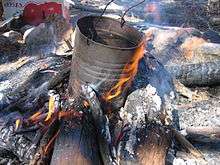
Billy tea is the drink prepared by the ill-fated swagman in the popular Australian folksong "Waltzing Matilda". Boiling water for tea over a camp fire and adding a gum leaf for flavouring remains an iconic traditional Australian method for preparing tea, which was a staple drink of the Australian colonial period.[1]
The nation also has a longstanding dairy industry (virtually from colonisation) and today produces a wide variety of cheeses, yoghurts, milk, cream, and butter products. Australians are high consumers of dairy products, consuming (on average) some 102.4 L of milk per person a year, which in part is due to its quality-coffee culture, 12.9 kg of cheese, 3.8 kg of butter (a small reduction from previous year, largely for dietary purposes) and a small increase to 7.1 kg of yoghurt products.[11]
The chocolate and malt powder Milo, which was developed by Thomas Mayne in Sydney in 1934 in response to the Great Depression, is mixed with milk to produce a popular beverage.
Alcoholic beverages

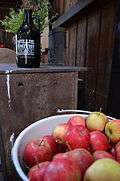
The Australian wine Industry is the fifth largest exporter of wine around the world, with 760 million litres a year to a large international export market and contributes $5.5 billion per annum to the nation's economy. There is also a significant domestic market for Australian wines, with Australians consuming nearly 500 million litres of wine per year in the early 21st Century. Wine is produced in every state, with more than 60 designated wine regions totaling approximately 160,000 hectares. Australia’s wine regions are mainly in the southern, cooler parts of the country, in South Australia, New South Wales, Victoria, and Western Australia. Amongst the most famous wine districts are the Hunter Region, Margaret River, Yarra Valley, and Barossa Valley and among the best known wine producers are Penfolds, Rosemount Estate, Wynns Coonawarra Estate and Lindeman's.[12] The Adelaide Hills region is also renowned for its wine production and attracts both national and international tourists.
Beer in Australia has been popular since colonial times. James Squire is considered to have founded Australia's first commercial brewery in 1798 and the Cascade Brewery in Hobart, Tasmania, has been operating since the early 19th century. Since the 1970s, Australian beers have become increasingly popular globally - with Fosters lager being an iconic export brand. However, Fosters is not a large seller on the local market, with alternatives such as Victoria Bitter & Carlton Draught outselling the popular export. Craft beer is popular, as well as distinctive products from smaller breweries such as Coopers and Little Creatures. [13] Australia has also in the past been known for producing high volumes of light lager style beers, mostly for domestic and export consumption, but since the 1990s has been producing many boutique and artisan quality beers that the general standard of public tastes have been improved as has local knowledge of boutique beers. Beers are served chilled in Australia, unlike in other parts of the world.
Rum served as a currency during the late 18th and early 19th centuries in Australia when metallic currency was in short supply.[14]
Coffee culture
Australia has a distinct coffee culture and is often cited as being one of the most developed and vibrant in the world.[15] The development of the coffee industry has grown not from coffee chains but through independent cafés born out of early Greek and Italian immigration since the early 20th century.

The iconic Greek cafés of Sydney and Melbourne were the first to introduce locally roasted coffees in 1910. In 1952, the first espresso machines began to appear in Australia and a plethora of fine Italian coffee houses were emerging in Melbourne and Sydney. Pelligrini’s Espresso Bar and Legend Café often lay claim to being Melbourne’s first ‘real’ espresso bars, opening their doors in 1954 and 1956 respectively. This decade also saw the establishment of one of Australia's most iconic coffee brands, Vittoria, which remains the country's largest coffee maker and distributor. The brand has existed in Australia since 1958, well before it moved to the US.[16]
The flat white was developed in Australia. The first documented appearance is at Moors Espresso Bar in 1985, where Alan Preston added it to his permanent menu. Preston subsequently opened 6 more outlets with Flat White on the menu, and this is most likely where the Flat White gets its Sydney start. It subsequently spread to New Zealand in the late 1980s. It has become extremely popular across the country and is Australia's most popular espresso beverage. The flat white's popularity has spread, and is beginning to take hold in the United Kingdom.
In the 1980s, Italy’s Lavazza coffee began its export business in Australia, a whole decade before expanding into the UK and US markets. Since this time espresso-based coffees have remained the most popular form of coffee amongst Australians.[17] Australia is also leading the way in the production of organic & Fair Trade coffee.
Although Australians often drink tea at home, it has been found that in out-of-home establishments where tea and coffee are sold together, tea accounted for only 2.5% of total sales. To this day, coffee chains such as Starbucks have very little market share in Australia. One reason for this is that unlike in the United States and Asia, Australia already had a developed coffee culture for many decades before coffee chains came to the market.[18]
Fish and seafood
.jpg)
Australia's 11 million square kilometre fishing zone is the third largest in the world and allows for bountiful access to seafood which significantly influences Australian cuisine. Clean ocean environments around Australia produce high quality seafoods for domestic consumption and export. Lobster, prawn, tuna, salmon, and abalone are the main ocean species harvested commercially, while aquaculture produces more than 60 species for consumption including edible oysters, salmon, southern bluefin tuna, mussel, prawn, barramundi, yellowtail kingfish, and freshwater finfish.[19]
While inland river and lake systems are relatively sparse, they nevertheless provide some unique fresh water game fish and crustacea suitable for dining. Fishing and aquaculture constitute Australia's fifth most valuable agricultural industry after wool, beef, wheat and dairy.[20] Approximately 600 varieties of marine and freshwater seafood species are caught and sold in Australia for both local and overseas consumption.
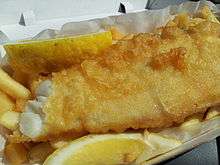
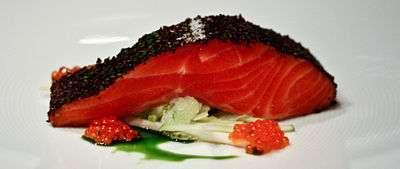
Australian cuisine features Australian seafood such as: southern bluefin tuna, King George whiting, Moreton Bay bug, mud crab, jewfish, dhufish (Western Australia) and yabby. Australia is one of the largest producers of abalone and rock lobster.
Fish and chips is a take-away food that originated in the United Kingdom and remains popular in Australia.[21] It generally consists of deep-fried fish (often flake rather than cod in Australia) batter with deep-fried chipped (slab-cut) potatoes. Flathead is also popular sport and table fish found in all parts of Australia. Barramundi is a fish found in northern Australian river systems.
Fruit
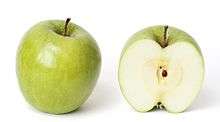
There are many species of Australian native fruits, such as Quandong (native peach), Wattleseed, Muntries / Munthari berry, Illawarra plums, Riberry, Native Raspberries and Lilli pillies.[22] These usually fall under the category of "bush tucker", (bush foods), which are used more commonly in restaurants and used in commercial preserves and pickles but are not generally well known to Australians due to low availability.
Australia also has large fruit growing regions in most states for tropical fruits in the north, stone fruits and temperate fruits in the south which has a mediterranean or temperate climate. The Granny Smith variety of apples first originated in Sydney, Australia in 1868.[23] Another well-known Australian apple variety is the Cripps Pink, known locally and internationally as "Pink Lady" apples, which was first cultivated in 1973.
Fruit is widely used in Australian cuisine, but is consumed mostly when it is fresh rather than when it is cooked. This is likely due to the successful "2 fruit and 5 veg" campaign for healthy daily portions encouraging consumption of fresh fruit.[24] In terms of cooked fruit dishes, fruits are often eaten poached in sugar syrup (often with spices such as vanilla, cloves or citrus peel) and eaten as a breakfast or dessert, which is more common amongst older Australians, or baked in dishes such as apple crumble, pies, pastries and cakes. Fresh fruit is often consumed simply without any adulteration at any time of day, or combined in fruit salad, which is a popular summer dessert nationally.
Popular and commonly available fruits produced in Australia are: apples, banana, kiwi fruit, oranges and other citrus, mangoes (seasonally), pears, nectarines, plums, apricots, grapes, melons, papaya (also called pawpaw), pineapple, passionfruit and berry fruits (such as strawberries, raspberries etc.). Other fruits tend not to be widely cultivated due to the plant requiring climate or soil conditions that are not cost effective, or the plant species not being well known to the general market. Many Australian homes in older suburbs will have fruit trees in the garden, mainly citrus and stone fruit, often of old-fashioned "heritage" varieties that are not suitable for commercial production.
Iconic foods

One iconic Australian food is Vegemite, a vitamin-rich, savoury yeast spread which is often thinly spread on buttered toast. Other unique or iconic national foods include macadamia nuts; Violet Crumble, a honeycomb chocolate bar; Cherry Ripe; Jaffas, chocolate with an orange-flavoured confectionery shell, much like an M&M, and the Chiko Roll, a deep-fried savoury roll similar to a spring roll. Other popular Australian foods include Tim Tams, a chocolate biscuit; musk sticks; Aeroplane Jelly; lemon delicious pudding; fairy bread, buttered bread with hundreds and thousands; lamingtons; and the commercial breakfast cereal Weet-Bix.
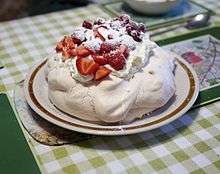
ANZAC biscuits and the pavlova are both iconic Australian national foods.[25][26] While the oldest known named recipe for pavlova is from New Zealand, it's often said in Australian history that the dessert took its name from Anna Pavlova at the Esplanade Hotel in Perth during a tour of the state where she danced "as light as air" in reference to the light meringue.[27] It has been suggested that the current pavlova is an improvement on the older recipe for a meringue cake found in a New Zealand magazine.[28]
In the pattern of foods named after famous singers and dancers, Dame Nellie Melba also has several dishes named after her; well known is Melba toast and the Peach Melba, but also less well known is the Chicken Melba, recipes of which can be found in Larousse Gastronomique.
The meat pie (minced beef in a beef gravy, enclosed in a baked flaky pastry shell about 10 cm across) is a well-known party food, often consumed by tradition on AFL Grand Final Day. Popular variants include steak, onion (diced fried onion), potato (mashed potato on top of a traditional pie instead of a pastry top), Indian curry and pepper. An iconic way of serving meat pies is as a "pie floater", on top of a bowl of thick pea soup. Sausage rolls are another popular take away item.
Lamb is very popular in Australia, with roasting cuts (legs and shoulders), chops, and shanks being the most common cuts. Lamb will often form part of either a Sunday roast or a barbecue. It is also commonly found as an ingredient in doner kebabs, a dish of Turkish origin that has been popular in Australia since the 1970s. According to the OECD-FAO Agricultural Outlook for 2016, Australia consumes more sheep meat than any other Western country, and the third-largest amount worldwide (after Sudan and Kazakhstan). Annually, Australians consume an average of 7.4 kilograms (16 lb) per person. By way of comparison, New Zealanders average 4.4 kilograms (9.7 lb) and Americans just 0.4 kilograms (0.88 lb).[29]
Damper is a traditional Australian soda bread prepared by swagmen, drovers and other travellers. It is a wheat flour based bread, traditionally baked in the coals of a campfire.
Damper is a traditional Australian soda bread prepared by swagmen, drovers and other travellers. It is a wheat flour based bread, traditionally baked in the coals of a campfire.
The Australian hamburger consists of a fried beef patty, served with shredded lettuce and sliced tomato in a (usually toasted) bread roll. Tomato sauce (similar to ketchup but made with less sugar with a more liquid texture) or barbecue sauce are almost always included. Beetroot, pineapple and fried onions are also common additions. Other frequently-served hamburger options are bacon, fried egg and cheese. Pickles are rarely included, except in burgers from American chains.[30]
State and Regional Iconic foods
As well as National icons there are many regional and State iconic foods. [31]South Australia has pasties - based on Cornish pasties, frut chocs, King George Whiting, and a range of food of German origin including metwurst, beesting, kuchen streusel(German cake)[32] and fritz. The state has its own iconic brands such as Farmers Union Iced Coffee, YoYo biscuits, Balfours Frog Cakes. Jubilee cake remains a specialty of South Australia and Mildura, Victoria.[33] Tasmania has leatherwood honey and abalone.[34] Queensland has Weis Fruit Bar and claims the lamington.[35]
Kangaroo meat is widely available in Australia, although it is not among the most commonly eaten meats. In old fashioned colonial recipes, it was treated much like ox tail, and braised until tender forming a rich gravy. It is available today in various cuts and sausages.[36] Also eaten and sold (in specialist restaurants and from select stores and supermarkets) is emu meat and crocodile meat.[37] As these meats need specialist preparation they are not commonly found in mainstream restaurants or home cooking.

_(cropped).jpg)
Prominent chefs
Prominent Australian chefs include:
- Stephanie Alexander
- Maggie Beer
- Shannon Bennett
- Guillaume Brahimi
- Jean-Paul Bruneteau
- Simon Bryant
- George Calombaris
- Pete Evans
- Manu Feildel
- Margaret Fulton
- Gabriel Gaté
- Peter Gilmore
- Bill Granger
- Guy Grossi
- Donna Hay
- Kylie Kwong
- Adam Liaw
- Cheong Liew
- Stefano Manfredi
- Gary Mehigan
- Matt Moran
- Luke Nguyen
- Ben O'Donoghue
- Mark Olive
- Neil Perry
- Tobie Puttock
- Peter Russell-Clarke
- Cindy Sargon
- Curtis Stone
- David Thompson
- Tetsuya Wakuda
- Poh Ling Yeow
- Iain Hewitson
See also
References
- 1 2 3 4 "Australian food and drink". Cultureandrecreation.gov.au. 23 September 2008. Archived from the original on 22 March 2011. Retrieved 17 September 2011.
- ↑ Australian Institute of Health and Welfare, Australia's food & nutrition 2012, 2012, p. 73
- ↑ L. Tapsell, Meat in the context of the whole diet: A social and cuisine perspective, Nutrition & Dietetics, Wiley Online Library, 2007
- ↑ "Modern Australian recipes and Modern Australian food : SBS Food". Sbs.com.au. Retrieved 17 September 2011.
- ↑ "About Native Australian food". SBS. 1 July 2008. Retrieved 17 March 2017.
- ↑ Newling, Jacqui (2015). Eat your history, stories and recipes form Australian kitchens. Sydney, Australia: Sydney Living Museums and NewSouth Publishing. pp. 19–62. ISBN 9781742234687.
- ↑ O'Brien, Charmaine (2016). The Colonial Kitchen. USA: Rowman & Littlefield. pp. Chapters 1, 2, 7. ISBN 9781442249813.
- ↑ R. Haden, Food Culture in the Pacific Islands, 2009, p. 46
- ↑ "Australian farms and farming communities - australia.gov.au". Cultureandrecreation.gov.au. 10 May 2011. Archived from the original on 8 April 2011. Retrieved 17 September 2011.
- ↑ "Vegetable growing in the Central West" (PDF). Dpi.nsw.gov.au. Retrieved 23 January 2018.
- ↑ "Dairy Australia - Consumption statistics". Dairyaustralia.com.au. Retrieved 23 January 2018.
- ↑ "Australia's wine industry". Cultureandrecreation.gov.au. 14 December 2007. Archived from the original on 17 February 2011. Retrieved 17 September 2011.
- ↑ "Changing beer habits to blame for profit decline". ABC News. 23 September 2011. Retrieved 9 December 2011.
- ↑ L. Allen, The Encyclopedia of Money, 2009, p. 268
- ↑ "Coffee Academy, Australia, Brisbane, Melbourne, Coffee Art". Barista Basics. 28 March 2006. Retrieved 17 September 2011.
- ↑ "Vittoria Coffee". Vittoriacoffee.com. Retrieved 23 January 2018.
- ↑ "Aussie café culture accounts for 'biggest growth in coffee' | Australian Food News". Ausfoodnews.com.au. 4 March 2010. Retrieved 17 September 2011.
- ↑ James Braund. "Caffeination: Australia's (obsessive) coffee culture - travel tips and articles". Lonely Planet. Retrieved 17 September 2011.
- ↑ "About Australia: The Australian seafood industry". Dfat.gov.au. Archived from the original on 6 February 2012. Retrieved 17 September 2011.
- ↑ "Fisheries Home". DAFF. 13 September 2011. Archived from the original on 25 September 2011. Retrieved 17 September 2011.
- ↑ "BBC - Ever Wondered Food - History". 18 November 2004.
- ↑ "Archived copy" (PDF). Archived from the original (PDF) on 25 January 2011. Retrieved 2010-10-20.
- ↑ "Granny Smith and her Apples". Archived from the original on 11 August 2007. Retrieved 11 August 2007.
- ↑ "Go for 2 & 5". Gofor2and5.com.au. Retrieved 23 January 2018.
- ↑ "Pavlova page". Aussie-info.com. Retrieved 17 September 2011.
- ↑ "Anzac biscuits" Archived 9 May 2008 at the Wayback Machine.
- ↑ Pavlova palaver, by Susette Goldsmith, New Zealand Listener (reviewing The Pavlova Story: A Slice of New Zealand’s Culinary History, By Helen Leach)
- ↑ "Hands off our pavlova, Kiwis warned - The West Australian". Au.news.yahoo.com. 3 December 2010. Retrieved 17 September 2011.
- ↑ Meat consumption, OECD Data. Retrieved 6 December 2016.
- ↑ "Australian burger recipe". burgers here and there. 2 March 2011. Retrieved 17 September 2011.
- ↑ "Favourite SA Food Icon". Adelaide Today.
- ↑ "Fritz – Traditional German Cake Recipe". www.fritzmag.com.au. Retrieved 2018-10-14.
- ↑ "Australia's cuisine culture: a history of our food - Australian Geographic". Australian Geographic. 2014-06-27. Retrieved 2018-10-14.
- ↑ "Top ten Tasmanian food specialities". www.tasmaniatopten.com. Retrieved 2018-10-14.
- ↑ "Q150 icons list". Brisbane Times. 2009-06-10. Retrieved 2018-10-14.
- ↑ "KIAA - Kangaroo Meat Cuts". Kangaroo-industry.asn.au. Archived from the original on 4 March 2016. Retrieved 17 September 2011.
- ↑ Woodgate, Thomas (3 November 2011). "Australian food: 40 dishes locals like to call their own". CNN Travel. Retrieved 27 July 2015.
Further reading
- Bruneteau, Jean-Paul, Tukka, Real Australian Food, ISBN 0-207-18966-8
- Cherikoff, Vic, The Bushfood Handbook, ISBN 0-7316-6904-5
- Cherikoff, Vic, Uniquely Australian, ISBN 0-646-07470-9
- Cherikoff, Vic and Christie, Benjamin, The Dining Downunder cookbook. ISBN 0-9752021-0-3
- Dwyer, Andrew, "Outback Recipes and Stories from the Campfire". ISBN 978-0-522-85380-3
- Kersh, Jennice. & Kersh, Raymond. (1998) Edna's Table (Restaurant) Rydalmere, N.S.W. Hodder & Stoughton. ISBN 0-7336-0539-7
- O'Brien, Charmaine. The Colonial Kitchen: Australia 1788-1901 (Rowman & Littlefield, 2016).
- Santich, Barbara. "The high and the low: Australian cuisine in the late nineteenth and early twentieth centuries." Journal of Australian studies 30.87 (2006): 37-49.
- Saunders, Alan. “Why Do We Want An Australian Cuisine?”. Journal of Australian Studies 30 (2006): 1-17.
External links
| Wikimedia Commons has media related to Cuisine of Australia. |
| Wikibooks Cookbook has a recipe/module on |
